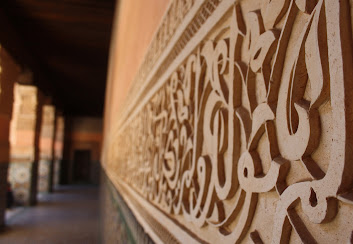The most important scripts known to calligraphers today are following
- Kufic
- Naskhi
- Thuluth
- Diwani
- Taliq
Kufic :
The name Kufic derives from the town of Kufah. The name has been attached to many forms of the early script as well as several varieties of script known to contemporary calligraphers.it is sufficient for us to know that Kufic today is used to designate any of the basically angular scripts. This was the main type of script used in all parts of the Muslim world for the Quran and epigraphy until the 12th century. The early Quran of the 3rd and 4th, 9th, and 10th centuries often have heavy kufi lettering with short verticals and exaggerated horizontals. Somewhat later example of Kufi script more often emphasize the verticals. As variant styles proliferated were often treated to elaborate painting techniques or were combined with architectural and other motifs.
Naskhi :
The singular importance of the Kufi typescripts, for decoration of manuscripts and other artwork, was not to last for long. Within 3 or 4 centuries the popularity of the various forms of rounded scripts had been established. Rounded scripts had been available from the first centuries of Islam, but it took some time before they gained acceptance and esteem as artistic lettering types.
Naskhi is a scribe script used for books and especially for copying the Quran. It owes its name to its association with the copying of books.
Thuluth :
Thuluth is another form of Islamic calligraphy art, but it is different in other characteristics and in function from Naskhi, with which it is often confused, or of which it is mistakenly taken to be variety. A much more likely explanation is that which accords such names to the different sized scripts which corresponds to various paper size n which they were used. The largest paper size was tumar. This paper was 24 animal hairs in width. Thuluth was a script fitting a paper size of ''one third '' that size, i.e. 8 hairs in width.
Thuluth has been used in a great variety of artistic creations in literary manuscripts and architectural monuments as well as in the production of small art objects. it was used in all parts of the Muslim world for elaborate arabesque decoration. It is also prominent in non-literary calligraphic decoration
Diwani :
It is Islamic calligraphic art that is so rounded that it might be described as the opposite of Kufi. It has no angles and emphasizes cursiveness. Diwani letters move straight across the page with non of the up and down positioning used in thuluth.
The script has a tendency to turn upwards at the end of the line. Diwani is written with or without harakat and is usually small and compact. It is also the main script for the Tughra . In tughra , Diwani script often found in combination with thuluth elements.
Taliq:
It is another example of Islamic calligraphy art which has played an important role in Islamic art. There are no sharp angles in this script, no ornate flourishes, or extra decorations. commonly held to have originated in 13th century Iran, this script is used for copying poetry as well as prose. but it is rarely used for copies of the Quran or for the decoration of architectural or small movable art objects. It is a small and legible script in which a few letters have slightly altered forms. An elaborate variation of this script is supposed to b developed by Mir Ali the famous artist of Tabriz, in the early 15th century. It has been used primarily for non-Arabic Islamic languages. some attempts were made in the last 16th century to write the Quran in this style, but t never gained popularity as an Arabic script. it is usually written without harakat.
Stay tuned for more informative blogs Thankyou.





Like always great content
ReplyDelete👍🏻
ReplyDeletevery nice information. keep ot up
ReplyDeleteVery Nice Blog.
ReplyDeleteKeep it up
I found so informative
ReplyDelete